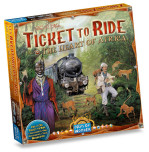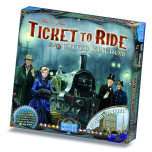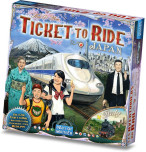We use cookies to make your experience better. To comply with the new e-Privacy directive, we need to ask for your consent to set the cookies. Learn more.
This game has become one of our family favorites. 2 to 5 players draw tickets to connect rail routes between major cities and attempt to complete them in the most direct route possible. Routes are built in sections of 1 to 6 railcars based on playing cards of the designated color for the section. Longer routes and longer sections score more points than shorter ones. Since routes can have sections that overlap, competition for certain segments adds to the excitement. Strategy is not too complicated, so that younger players are not at a disadvantage. Games take from 45 to 75 minutes, depending on the number of players. The basic game is based on North American geography, while TTR Europe has slightly different rules and covers Europe and eastern Asia. TTR USA 1910 is an expansion that allows 3 more variations of the basic TTR game. Ticket to Ride Expansions (3-AD) (ages 8+) Across the exotic lands of Asia, from Africa, to Germany, and all the way to the Northern face of Europe, the rumble of locomotives can be heard around the world. Explore wildly different locations and circumstances around the globe as you expand your train lines in these new Ticket to Ride editions. The gameplay is similar to the original Ticket to Ride, but each map has its own challenges to overcome, including mountains, valleys, ferries, rough terrain, tolls, and other unique regional challenges. Despite the varying climates, treacherous landscapes, and locational nuances, your goal is the same. Create the best route, collect the most valuable tickets, and connect cities to beat your competition! Games listed as Expansions require Ticket to Ride or Ticket to Ride Europe to play. Other editions are stand-alone and require no other Ticket to Ride games to play. Games last roughly 30-60 minutes.Happy travels!
























